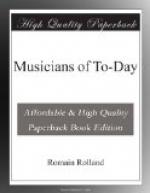Such a programme serves rather to lead the listener astray than to guide him. It spoils the idea of the work by emphasising its anecdotal and rather comic side. For without doubt the comic side is there, and Strauss has warned us in vain that he did not wish to make an amusing picture of married life, but to praise the sacredness of marriage and parenthood; but he possesses such a strong vein of humour that it cannot help getting the better of him. There is nothing really grave or religious about the music, except when he is speaking of the child; and then the rough merriment of the man grows gentle, and the irritating coquetry of the woman becomes exquisitely tender. Otherwise Strauss’s satire and love of jesting get the upper hand, and reach an almost epic gaiety and strength.
But one must forget this unwise programme, which borders on bad taste and at times on something even worse. When one has succeeded in forgetting it one discovers a well-proportioned symphony in four parts—Allegro, Scherzo, Adagio, and Finale in fugue form—and one of the finest works in contemporary music. It has the passionate exuberance of Strauss’s preceding symphony, Heldenleben, but it is superior in artistic construction; one may even say that it is Strauss’s most perfect work since Tod und Verklaerung ("Death and Transfiguration"), with a richness of colouring and technical skill that Tod und Verklaerung did not possess. One is dazzled by the beauty of an orchestration which is light and pliant, and capable of expressing delicate shades of feeling; and this struck me the more after the solid massiveness of Mahler’s orchestration, which is like heavy unleavened bread. With Strauss everything is full of life and sinew, and there is nothing wasted. Possibly the first setting-out of his themes has rather too schematic a character; and perhaps the melodic utterance is rather restricted and not very lofty; but it is very personal, and one finds it impossible to disassociate his personality from these vigorous themes that burn with youthful ardour, and cut the air like arrows, and twist themselves in freakish arabesques. In the adagio depicting night, there is, though in very bad taste, much seriousness and reverie and stirring emotion. The fugue at the end is of astonishing sprightliness; and is a mixture of colossal jesting and heroic pastoral poetry worthy of Beethoven, whose style it recalls in the breadth of its development. The final apotheosis is filled with life; its joy makes the heart beat. The most extravagant harmonic effects and the most abominable discords are softened and almost disappear in the wonderful combination of timbres. It is the work of a strong and sensual artist, the true heir of the Wagner of the Meistersinger.
* * * * *
Upon the whole, these works make one see that, in spite of their apparent audacity, Strauss and Mahler are beginning to make a surreptitious retreat from their early standpoint, and are abandoning the symphony with a programme. Strauss’s last work will lose nothing by calling itself quite simply Sinfonia Domestica, without adding any further information. It is a true symphony; and the same may be said of Mahler’s composition. But Strauss and Mahler are already reforming themselves, and are coming back to the model of the classic symphony.




